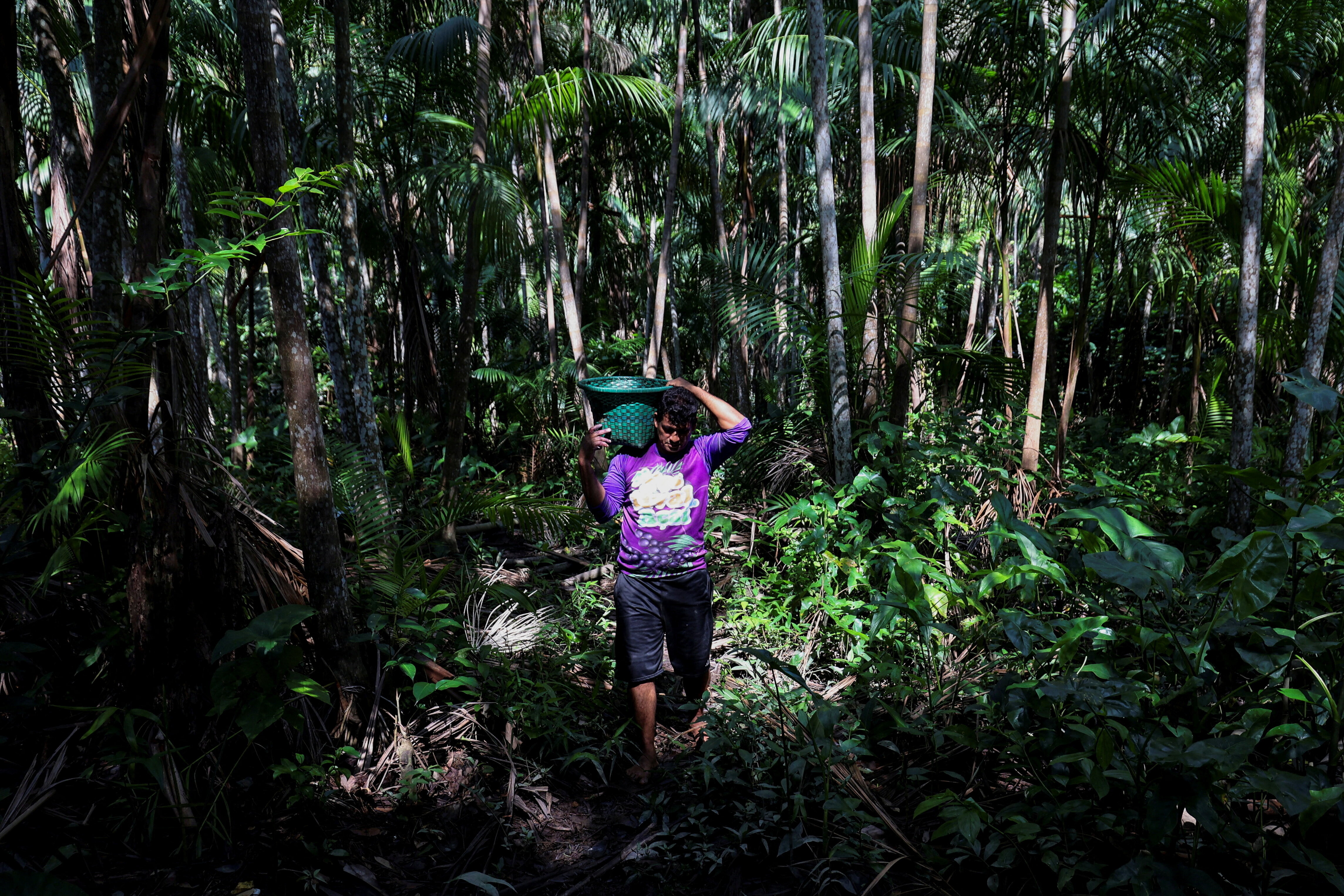Opinion
Why shifting food behaviours will require talking to our primal selves

Carbon dioxide (CO2) emission levels have risen dramatically in recent decades and our food system accounts for about 25% of them. Image: Unsplash/LikeMeat
Listen to the article
- Carbon dioxide emissions have soared in recent decades and our global food system accounts for about a quarter of them.
- There is growing awareness about how eating meat impacts the environment, but more needs to be done to encourage a plant-based diet.
- Products that look, taste and smell like the food they replace are key to tapping into our pleasure and encouraging repeat purchases.
Carbon dioxide (CO2) emission levels have risen dramatically in recent decades and our food system accounts for about 25% of them. Meanwhile, all the most greenhouse gas (GHG) intensive foods have grown in adoption, despite our knowledge of how diet impacts the environment has increased. So how can we encourage people to eat better for the environment?
Climate anxiety isn’t necessarily translating into diet change, mainly because what we eat defines who we are, and most humans don’t like to put their identity on the grill. Familiarity and crave-ability are central concepts to keep us closer to who we are, give us pleasure, and reassure us. However, if properly leveraged, they can be the driving force for change.
Since the outbreak of the Second World War, we have recorded atmospheric carbon dioxide levels rising to 1.3 parts per million per year – four times faster than in the previous 100 years and 400 times faster than in the last 5,000 years.
CO2 is Earth’s most important greenhouse gas, as it absorbs and radiates heat. According to observations by the NOAA Global Monitoring Lab, in 2021 carbon dioxide alone was responsible for about two-thirds of the total heating influence of all human-produced greenhouse gasses.
Why food is crucial to tackling carbon emissions
The Intergovernmental Panel on Climate Change's (IPCC) Special report on Climate Change and Land recently attributed to food systems between 11 and 19 billion tones of emissions per year, contributing to about one fourth of anthropogenic emissions of carbon dioxide, methane (CH4) and nitrous oxide (N2O) combined as CO2 equivalents.
There is rightly a growing awareness about how our food choices have a significant impact on our carbon footprint. What we eat is the most important choice to focus on, which is far more relevant than eating local, as greenhouse gas emissions from transportation make up a very small amount of the ‘foodprint’.
Animal proteins and fats, chocolate, coffee and vegetable oils score at the top of the food carbon footprint list when it comes to emissions.
If we factor in deforestation and water consumption, a new study highlights a few additional foods to watch out for, including: types of fish like cod, flounder and halibut because of the trawling damages to the seafloor; rice and wheat because of their water consumption and deforestation; and crops used for cooking oils for their natural habitat disturbances.
Where we are on shifting food behaviours
Despite our increasing knowledge about the environmental impact of our food, global meat consumption increased by 58% between 1998 and 2018; vegetable oil consumption registered an approximately 30% increase since 2013 (and yes, also the strongly demystified palm oil, saw a 42% bump); rice consumption worldwide increased of 17% since 2008, and wheat recorded a 6% rise.
Knowledge alone, however, is not enough to change behaviour. Despite a growing number of people knowing that transitioning to a vegan diet would be one of the most impactful actions they could make to prevent climate change, there are only 79 million vegans worldwide, accounting for under 1% of the population.
What would make us change the way we eat?
A study published by The Lancet found that 84% of children and young adults ages 16 to 25 are at least moderately worried about climate change, and 59% are very or extremely worried. Climate anxiety is real, and it’s rooted in uncertainty about the future and alerting us to the dangers of a changing climate.
But this fear isn’t leading us to massively change our diets. Why? As one of my former professors, social scientist Claude Fischler said, back in 1988: “Food is central to our sense of identity. The way any given human group eats helps it assert its diversity, hierarchy and organization, but also, at the same time, both its oneness and the otherness of whoever eats differently.
“Food is also central to individual identity, in that any given human individual is constructed, biologically, psychologically and socially by the foods he/she chooses to incorporate.”
Given this context, it’s easy to realize why changing who we are – our diets – in the name of a foreign, threatening, uncontrollable event – climate change – is hard. If only we could make the current climate crisis talk to our identity, our primal self, things might be different. That’s where familiarity and pleasure come into play.
Leverage human familiarity with food as pleasure
Something familiar is frequently seen or experienced, easily recognized; in short, it’s easy to control. Unsurprisingly, control was defined as one of the deep human desires by Food for Climate League: providing a sense of agency able to reassure and guide us. The second wave of alternative meat and dairy was born from this premise.
About 15 years ago more people started realizing that asking new generations to give up very familiar foods, to decrease the temperature raise their previous generations were mainly responsible for, was extremely hard (and unfair) to ask.
This is when the first company belonging to this food wave was founded: Beyond Meat, 2009. The theory here is that if you create a product that tastes, bleeds and looks like the beef burger you grew up with, although not being made from animals, it will serve your need for familiarity, and you’ll choose it. Over a decade later, the plant-based meat, dairy and seafood industry is now valued at $7.4 billion.
Despite the countless challenges that have arisen this year – such as the fear of the ultra-processed nutritional label, lack of sensory profile and retail prices higher than animal meat – centring on familiarity made a new industry appear. Now it’s time to go beyond the first purchase.
When we eat something, our internal reward system has two distinct elements: desire and pleasure. While dopamine makes us want, the liking part comes from opioids which paint a “gloss of pleasure”, as Berridge puts it, on good experiences. It doesn’t seem too simplistic to say that, at a sensorial level, pleasure is what fires recurrent purchases up.
Tenderness, juiciness and flavour have been associated with consumer acceptance of beef, lamb and pork. Animal age, diet and subsequent marbling impact consumer liking across species. It is about the perfect level of fat, the "around mouth" feel, the impactful (and familiar) flavour that makes our mouth water and calls the waiter for a second round.
What is the World Economic Forum doing to help ensure global food security?
While familiarity is key to support transitions, pleasure is the spicy kick needed to go beyond what we’re used to. They are the perfect combination of wildness and reassurance, and need to be properly balanced depending on the audience.
The ultimate goal? Eat sustainably without thinking of it, desire the food options that make us decrease our footprint, and pleasure consumers to the point they can’t wait for a second serving.
Don't miss any update on this topic
Create a free account and access your personalized content collection with our latest publications and analyses.
License and Republishing
World Economic Forum articles may be republished in accordance with the Creative Commons Attribution-NonCommercial-NoDerivatives 4.0 International Public License, and in accordance with our Terms of Use.
The views expressed in this article are those of the author alone and not the World Economic Forum.
Stay up to date:
Food Security
Forum Stories newsletter
Bringing you weekly curated insights and analysis on the global issues that matter.








